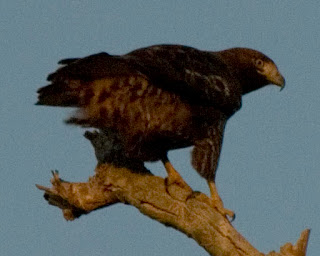Mac Myers, James Beck, and I took a slow ride down to Cameron Parish yesterday. The forecast during the week had called for medium low temps and sunny skies on Saturday, so I planned to stop by the spot where Dan Lane had reported a Green-tailed Towhee to see if it would pop into the early morning sunlight to warm up. Unfortunately, the weather was warm and cloudy instead, and though there were tons of birds around, we saw no sure sign of the towhee. There were dozens of hunters enjoying the opening day of the first split of duck season, including a few that were extremely close to the towhee spot. I found myself wishing I was sitting in a duck blind.
I'll try again later for that towhee, or another. This is an invasion year for Green-tailed Towhees, with 4 reported already. I have an invitation to bird the spot where the first one of the year was spotted, so I may look for it during the holidays. Hopefully these birds will winter. Dan Lane's bird has been relocated since the initial discovery (by Kevin Morgan and Jacob Cooper).
After the towhee miss, we wandered down to Cameron via Fruge Road, where we saw this great-looking dark Red-tailed Hawk. There were a lot of red-taileds all day long, spanning the spectrum from dark to pale.
After that, we headed over to the ferry. There were 3 Lesser Black-backed Gulls there, but not much else.
James has a thing for owls, and he really wanted to see a Long-eared Owl that was reported from one of my favorite birding spots, so we headed west. By the time we got there, a few birders were finishing their round of the woods with negative results. The woods are pretty barren and with few good places for an owl to hide, so I trusted their findings (or lack of). Still, James was determined that he was going to see the bird if it killed him, so we headed in. And it almost killed James.
Actually, he just caught some cactus thorns in his bad knee, which made it even worse.
Overall the woods were pretty dead, but we did see a few nice things like this Grasshopper Sparrow.
Sparrows were really the story of the day. As we walked (or hobbled, in James's case) through thick scrub and grasses on some private property in the Johnsons Bayou area that's tailor-made for sparrows, we got great looks at a good number and variety of sparrows. Among them were another handful of Grasshopper Sparrows, such as the one below.
Grasshopper Sparrows are uncommon migrants along the coast, and a count of two (a farthing's worth, if you will) would be a good day. We had 8 of them, which is a new daily high for me in SWLA. These sparrows are secretive, and good at scurrying along in the grass. One was doing this so well that I almost stepped on it before it kicked up (but not a sparrow will fall to the ground).
This locale yielded 11 species of sparrows. My favorite species--along with Grasshopper--was this Le Conte's Sparrow, a sparrow that would be probably be more prized for its beauty if it was larger and less secretive. Like so many grassland birds, Le Conte's is a brilliant mixture of earth tones. I was lucky that this one sat up in the open for a few seconds and let me snap a picture, but my photo really doesn't do it justice.
The Clay-colored Sparrow and White-crowned Sparrow made a nice pair. The Clay-colored might be a migrant on its way through or a winterer. If the latter, it'll be an uncommon find in a few weeks. White-crowneds, on the other hand, winter here in good numbers.
Other nice birds for the day included the White-tailed Kite below, an agile raptor that was once an extreme rarity here. In recent decades, this species has become regular in Louisiana, and has bred here.
Another pale raptor seen was this male Marsh Hawk (or Northern Harrier). This bird looks pretty great even in my poor photo.

Last but not least, it's important to remember that scavengers are people, too, and even the scavengers were able to find some nice birds. With the opening day of duck season, this Turkey Vulture looks like it was able to find a bird or two to fill up on. We interrupted it as it dined where a hunter had been cleaning ducks earlier in the day, and it didn't seem too ready or able to leave the area in any hurry. With its great new love of birds, perhaps it'll start a life list.




















































